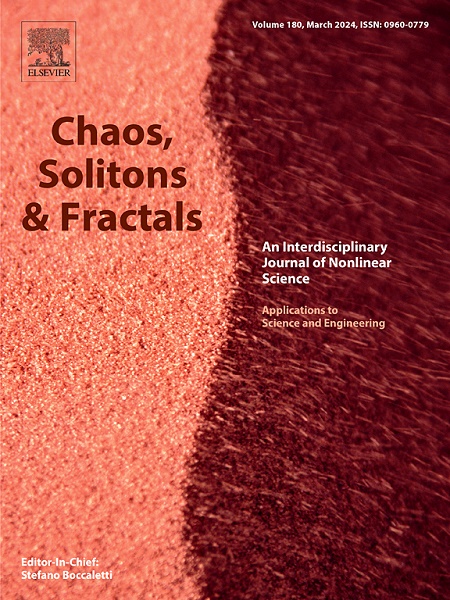Chaos links dendritic calcium to bursting in hippocampal pyramidal cells
IF 5.3
1区 数学
Q1 MATHEMATICS, INTERDISCIPLINARY APPLICATIONS
引用次数: 0
Abstract
We perform a multi-parameter bifurcation analysis of the Pinsky–Rinzel neuron model. Varying input currents to the soma and dendrite allows for the emergence of multiple dynamical regimes, including resting states, periodic cycles, tori, and chaotic states. The existence of tori implies the coexistence of two distinct frequency bands, which may underlie theta–gamma coupling observed in hippocampal activity. Additionally, a comprehensive bifurcation analysis reveals a novel type of chaotic attractor spanning a wide parameter region defined by inward currents to the soma and dendrite of a pyramidal neuron. This attractor facilitates the coexistence of two distinct bursting regimes as responses to the same stimulus. These bursting patterns, both previously observed experimentally in vivo and in vitro, primarily differ in dendritic calcium levels, with one exhibiting significantly elevated calcium concentrations. In this study, we introduce a robust method for identifying the bifurcation boundary of a global attractor associated with bursting behavior. The method is based on a comparative analysis of numerical continuation and grid-based simulations and can be applied analogously to other models. This rigorous approach not only provides a mechanistic explanation for experimentally observed concurrent neuronal responses to identical stimuli but also demonstrates that the Pinsky–Rinzel model, despite simplifying the pyramidal cell into two compartments, effectively captures a wide range of dynamical regimes present in pyramidal cell signaling. Moreover, it highlights the model’s robustness in describing complex neuronal dynamics, including epileptic activity.
混乱将树突状钙与海马体锥体细胞的破裂联系起来
我们对Pinsky-Rinzel神经元模型进行了多参数分岔分析。不同的输入电流到体细胞和树突允许出现多种动态状态,包括静息状态,周期循环,环面和混沌状态。tori的存在意味着两个不同频带的共存,这可能是海马活动中观察到的θ - γ耦合的基础。此外,综合分岔分析揭示了一种新型的混沌吸引子,它跨越了一个由向内电流定义的锥体神经元的体细胞和树突的宽参数区域。这一吸引子促进了两种截然不同的爆破制度共存,作为对同一刺激的反应。这些破裂模式,先前在体内和体外实验中都观察到,主要是树突钙水平不同,其中一种表现出明显升高的钙浓度。在这项研究中,我们引入了一种鲁棒方法来识别与破裂行为相关的全局吸引子的分岔边界。该方法是基于数值延拓和网格模拟的对比分析,可以类似地应用于其他模型。这种严谨的方法不仅为实验观察到的对相同刺激的并发神经元反应提供了机制解释,而且还证明了pinski - rinzel模型,尽管将锥体细胞简化为两个区室,但有效地捕获了锥体细胞信号传导中存在的广泛动态机制。此外,它突出了模型在描述复杂神经元动力学(包括癫痫活动)方面的鲁棒性。
本文章由计算机程序翻译,如有差异,请以英文原文为准。
求助全文
约1分钟内获得全文
求助全文
来源期刊

Chaos Solitons & Fractals
物理-数学跨学科应用
CiteScore
13.20
自引率
10.30%
发文量
1087
审稿时长
9 months
期刊介绍:
Chaos, Solitons & Fractals strives to establish itself as a premier journal in the interdisciplinary realm of Nonlinear Science, Non-equilibrium, and Complex Phenomena. It welcomes submissions covering a broad spectrum of topics within this field, including dynamics, non-equilibrium processes in physics, chemistry, and geophysics, complex matter and networks, mathematical models, computational biology, applications to quantum and mesoscopic phenomena, fluctuations and random processes, self-organization, and social phenomena.
 求助内容:
求助内容: 应助结果提醒方式:
应助结果提醒方式:


